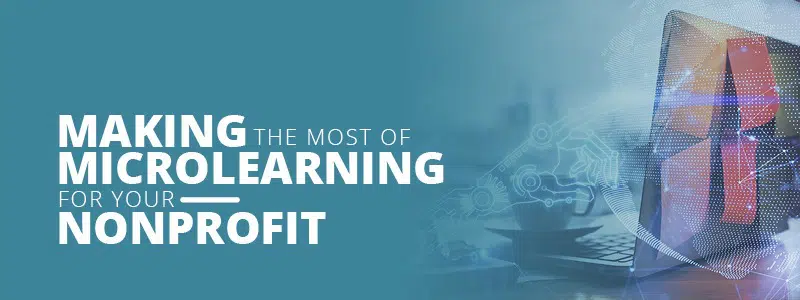Making the Most of Microlearning for Your Nonprofit


Full Platform Overview Chat With Us



Full Platform Overview Chat With Us




It’s a Monday afternoon and you’re researching e-learning solutions for your team. Maybe you’re looking for new ways to engage and develop your remote workforce. Or, maybe your supervisor has identified a pervasive problem across your team, and you’re looking for a training solution to help your staff overcome it.
During your research, you stumble across microlearning—apparently, a buzzword in the e-learning community. But, what is microlearning? And, can it actually be beneficial when educating your team members?
Here at Artisan E-Learning, we work with nonprofits, associations, and businesses to custom-develop e-learning courses. After years of doing so, we’ve stumbled across a few frequently asked questions that nonprofits have about microlearning.
So, let’s answer these questions and discuss how you can use microlearning to train your nonprofit’s staff and volunteers.
Quick question: As a nonprofit professional, what do you think microlearning is?
Maybe you’ve heard microlearning courses are shorter, say, less than five minutes long. Or, maybe you’ve heard microlearning is the practice of breaking up your longer courses into smaller chunks, so they’re easier to understand for learners with short attention spans.
It’s time for a quick reality check—neither of these definitions is correct.
When we discuss microlearning, we’re not discussing the length of the course. We’re discussing the content of the course. Microlearning is all about being laser-focused on one topic and fully exploring that subject alone.
Microlearning isn’t about making your course smaller; it’s about making your goal smaller.
So, take a step back before taking metaphorical scissors to your valuable hour-long courses. While “chunking” achieves the goal of smaller courses, it doesn’t mean you’re creating effective microlearning courses. In reality, you’ve created four 15-minute courses that might frustrate a staff member who thinks the first 15-minute course in the lineup is the only one they need to complete.
So to recap—microlearning isn’t a specific format (e.g. game, simulation, PDF… we could go on) or a certain length of course. It’s a course that achieves a single learning outcome.
Take a quick look at your staff and volunteers. Are a few people (okay, most people) wearing many hats? Maybe you have a volunteer director who’s writing a weekly newsletter, planning a year-end virtual event, training new supporters, and of course, managing those who generously help your organization each week.
That’s just an example of one role—and we’d bet it’s the norm across your organization. So, why would a course targeting a single learning outcome benefit your staff and volunteers?
Well, it turns out that microlearning has a variety of benefits for your team:
There’s also the fact that having a laser-focus on one topic removes any “busy work” for your team. During times of high stress, whether during the current COVID-19 crisis or the last few fundraising days of a major campaign, you have to re-evaluate what’s most important right now. Microlearning can bring that information to the forefront.
Now that we’ve covered the theoretical aspects of microlearning, how can this be applied to your team?
Let’s say you want to incorporate digital gift asks into your fundraising strategy. But, when you sent out a call for volunteers, the responses were few and far between. You quickly realize volunteers are nervous to make cold calls, let alone ask those people for money.
This is a great opportunity to bring in a microlearning course to build volunteers’ confidence. While soliciting donations is a broad idea—too broad for a microcourse—soliciting donations via phone has potential.
For example, you could create a course on phone etiquette. What is the right salutation for when the call is answered? How should you end the phone call? How should you respond when someone says “no?”
Answer these questions and have fun with it! At Artisan, we wanted to make a course covering common grammar mistakes. The e-learning game tests the learner while educating them and has a whimsical feel. This same idea can remove the stress from an intimidating topic, such as speaking with strangers on the phone.
If creating a microcourse seems like the right fit for your situation, make sure you understand your team’s next steps.
It isn’t as simple as filming a quick video where a member of your staff discusses one process. To create an effective microcourse, there are a few basic steps your nonprofit will need to follow:
When all is said and done, evaluate the course to make sure it meets your needs. Remember, the goal of the course is to improve your team’s performance in some way. No one wants to take a course just to say they completed it. If there’s not a clear benefit to your team and their performance, head back to the drawing board.
Microlearning provides a just-in-time solution, actionable tips, and quick results. For these reasons, it’s a powerful tool to educate nonprofit staff and volunteers alike. So, next time you encounter a specific challenge across your team, consider investing in a microcourse!


Comments